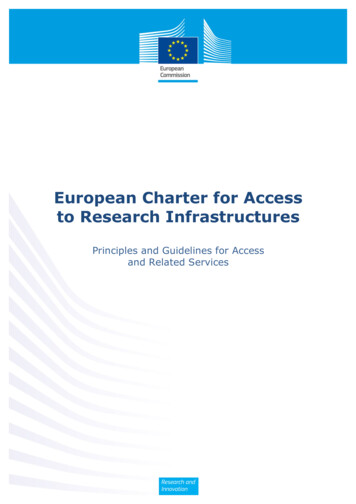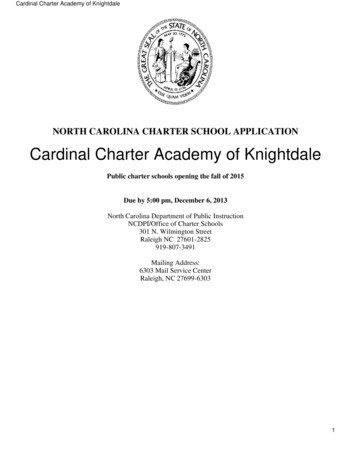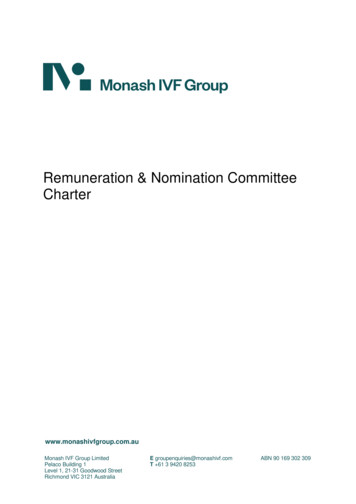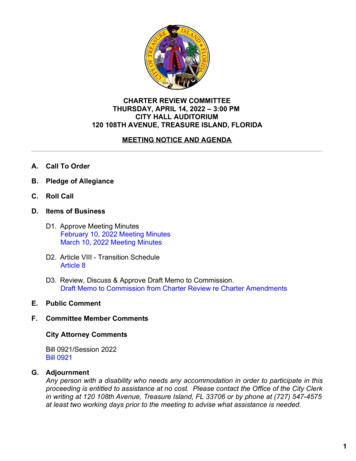
Transcription
European Charter for Accessto Research InfrastructuresPrinciples and Guidelines for Accessand Related Services
EUROPEAN COMMISSIONDirectorate-General for Research and InnovationDirectorate B – Open Innovation and Open ScienceUnit B4 – Research InfrastructuresContact: Andrea De CandidoE-mail: S@ec.europa.euEuropean CommissionB-1049 Brussels
EUROPEAN COMMISSIONEuropean Charter for Accessto Research InfrastructuresPrinciples and Guidelines for Accessand Related Services2016Directorate-General for Research and Innovation
EUROPE DIRECT is a service to help you find answersto your questions about the European UnionFreephone number (*):00 800 6 7 8 9 10 11(*) The information given is free, as are most calls (though some operators, phone boxes or hotels may charge you)LEGAL NOTICENeither the European Commission nor any person acting on behalf of the Commission isresponsible for the use which might be made of the following information.The views expressed in this publication are the sole responsibility of the author and do notnecessarily reflect the views of the European Commission.More information on the European Union is available on the internet (http://europa.eu).Luxembourg: Publications Office of the European Union, 2015.ISBN: 978-92-79-45600-8 European Union, 2016.Reproduction is authorised provided the source is acknowledged.doi:10.2777/524573KI-04-15-085-EN-N
TABLE OF CONTENTPREAMBLE . 61.PURPOSE . 82.APPLICABILITY . 83.DEFINITIONS . 94.PRINCIPLES .105.GUIDELINES .116.REVIEW AND UPDATE .135
PREAMBLEResearch Infrastructures, including e-infrastructures, are at the core of the knowledgetriangle of research, education and innovation and therefore play a vital role in theadvancement of knowledge and technology and their exploitation. By offering highquality services to Users from different countries, engaging young people, attracting newUsers and preparing the next generation of researchers, Research Infrastructures help instructuring the scientific community and play a key role in the construction of an efficientresearch and innovation environment. Support to the effective and efficient constructionand operation of Research Infrastructures is a key priority in realising the EuropeanResearch Area and in promoting open science and open innovation. Because of theirability to assemble a critical mass of people, knowledge and investment, ResearchInfrastructures contribute to regional, national, European and global developmentand are one of the most efficient tools to facilitate international cooperation in science.Research Infrastructures are also crucial in helping Europe lead a global movementtowards open, interconnected, data-driven and computer-intensive research,experimental development, as well as education and training. They increase thecreativity in and efficiency of research and bridge the gap between highly developed andlesser-developed regions. To an increasing extent, Research Infrastructures compriseelements of digital services, making the infrastructures and their services moreaccessible and enabling collaboration among Users across scientific domains andgeographical boundaries. From a User s perspective, the remote access can lead to asituation in which the physical location of the Research Infrastructure becomes lessrelevant. This nature of Research Infrastructures (and data involved) poses a number ofchallenges in relation to data ownership and to the necessity of providing transparencyand Access to it. The exponential growth of data moreover poses challenges to itseffective handling and its costs of curation and storage.Just as public infrastructures are key to civil society, Research Infrastructures are thebackbone of scientific communities and by now are well established in all disciplines. Thisspread has happened not least under the influence of increasingly importantinterdisciplinary User communities, digital science and of the move towards open accessto scientific publications and data.Strong investment in research and innovation is needed to address pressing globalsocietal challenges, such as climate change, health and ageing population, and themove towards a resource efficient society. Research Infrastructures play a vital role inaddressing these challenges. However, it is essential to optimise the use of scarceresources for increasingly expensive facilities, to overcome the fragmented ResearchInfrastructure spending, not only across Europe, but at a more global scale and to joinforces to address these challenges. As such, the scale and scope of scientific investigationand the challenges driving the development of large Research Infrastructures deserveparticular attention. When Access to Research Infrastructures is granted among researchorganisations, it should not be burdened by inappropriate taxation.Stronger interaction and cooperation between Research Infrastructures, Users andproviders from industry and public services builds bridges between the public,commercial and Research Infrastructure worlds. Dedicated initiatives can help increaseknowledge and technology transfer from science to industry and public services and6
help driving innovation. In addition to acting as Users, industry also plays anincreasing role in the construction, operation and innovation of Research Infrastructures.Finally, the nature and complexity of the societal challenges require a global approachand Access to the best Research Infrastructures, regardless of their location, is aprerequisite to achieve scientific excellence and socio-economic impact.7
1.PURPOSEIn the context of the implementation of the European Research Area, this Chartersets out non-regulatory principles and guidelines to be used as a referencewhen defining Access policies for Research Infrastructures and related services.While not having any legally binding nature, Research Infrastructures areencouraged to use this Charter as a reference when updating existing or definingnew Access policies. In addition, the funding organisations of ResearchInfrastructures are invited to promote this Charter’s provisions.This Charter promotes Access to Research Infrastructures in order to conductinnovative research and development, to improve the related methods and skills inthe workforce and to foster collaboration.This Charter moreover promotes interaction with a wide range of social and economicactivities, including, as appropriate, business, industry and public services, inorder to maximise the return on investment in Research Infrastructures and to driveinnovation, competitiveness and efficiency in terms of use of the scarce resourcesavailable.2. APPLICABILITYThis Charter addresses Access to Research Infrastructures as defined below and maybe taken into account when defining policies for providing Access in order to conductresearch, to undertake experimental development, to provide education and trainingand to deliver services.This Charter is primarily targeted at those responsible for the definition of the Accesspolicy to any given Research Infrastructure and, therefore, at the ResearchInfrastructures themselves, at the institutions to which they belong and at theirrespective research funding organisations.A number of resources complement this Charter providing best practices andconcrete guidance on the topics raised to those responsible for the definition ofAccess policies1.While expressing the European approach for Access to Research Infrastructures, thisCharter is offered as a reference document worldwide.1The Access to Research Infrastructures section of the European Commission's Research ructures/index en.cfm?pg access ri8
3.DEFINITIONSa. Research Infrastructures‘Research Infrastructures’ are facilities, resources and services that are used bythe research communities to conduct research and foster innovation in their fields.They include: major scientific equipment (or sets of instruments), knowledgebased resources such as collections, archives and scientific data, e-infrastructures,such as data and computing systems and communication networks and any othertools that are essential to achieve excellence in research and innovation. Theymay be 'single-sited', 'virtual' and 'distributed'2.b. Users‘Users’ of Research Infrastructures can be individuals, teams and institutions fromacademia, business, industry and public services. They are engaged in theconception or creation of new knowledge, products, processes, methods andsystems and also in the management of projects. Teams can include researchers,doctoral candidates, technical staff and students participating in research in theframework of their studies.c. Access‘Access’ refers to the legitimate and authorised physical, remote and virtualadmission to, interactions with and use of Research Infrastructures and toservices offered by Research Infrastructures to Users. Such Access can begranted, amongst others, to machine time, computing resources, software, data,data-communication services,trust and authentication services, samplepreparation, archives, collections, the set-up, execution and dismantling ofexperiments, education and training, expert support and analytical services.d. Access UnitThe Access Unit is a measure specifying the Access offered to the Users. ResearchInfrastructures are responsible for the definition of Access Units, which may varyfrom e.g. precise values like hours or sessions of beam time processing time, togigabytes transmitted for the conduction of complex experiments and projects upto quotations based on an inventory of Users' needs.2Article 2 (6) of Regulation (EU) No 1291/2013 of 11 December 2013: "Establishing Horizon 2020 – theFramework Programme for Research and Innovation (2014-2020)"9
4.PRINCIPLESa. Access policyResearch Infrastructures should have a policy defining how they regulate, grantand support Access to (potential) Users from academia, business, industry andpublic services.b. Acknowledgement and co-authorshipUsers should acknowledge the contribution of the Research Infrastructure in anyoutput (i.e. publication, patent, data, etc.) deriving from research conductedwithin its realms. In accordance with good scientific practice, Users areencouraged to offer co-authorship to those working at the Research Infrastructurehaving made genuine scientific contributions to their work.c. Legal conformityResearch Infrastructures must comply with national and international law andagreements, particularly, but not only, in areas such as intellectual property rightsand the protection of privacy, ethical considerations as well as safety, security andpublic order regulations when designing rules and conditions for Access to and useof Research Infrastructures.d. Costs and feesAcknowledging a variety of financing models, costs need to be covered and feesfor Access, to the extent found necessary, should contribute to the financialsustainability of the Research Infrastructure.e. Ethical conduct and research integrityResearch Infrastructures and Users should undertake the necessary actions toadhere to the standard codes of conduct and ethical behaviour in scientificresearch and to research integrity3.f. Non-discriminationIn granting Access to Users Research Infrastructures shall not discriminate on anypersonal grounds and may consider establishing equal opportunities policies.g. ImplementationThe administration connected to requesting and granting Access to ResearchInfrastructures should be kept to a minimum.3The European code of conduct for research integrity drafted by the European Science Foundation (ESF) andthe European Federation of National Academies of Sciences and Humanities (ALLEA) sets out eight principlesthat Researchers need to abide to: honesty in communication, reliability in performing research, objectivity,impartiality and independence, openness and accessibility, duty of care, fairness in providing references ent/ALLEA/Themes/Scientific%20Integrity/Code Conduct Research Integrity.pdf10
h. Research data managementResearch Infrastructures should have a research data management policyensuring that research data are appropriately maintained, archived for areasonable period, and available for review and (re-)use. Research Infrastructuresand Users should have an agreement on how to (re-)use the data. If appropriate,they are also encouraged to consider providing open access to research data.i. User instructionResearch Infrastructures should provide the Users with instructions for theeffective and efficient Access to a Research Infrastructure.5. GUIDELINESa. Access policyThe Access policy of a Research Infrastructure should define the Access in termsof Access Units, state the specific Access mode, clarify the conditions for Access,describe the processes and interactions involved in the Access and elaborate onthe support measures facilitating the Access, if existing.b. Access modesAccess to Research Infrastructures may be provided according to three differentAccess modes, i.e. excellence-driven , market-driven and wide .Acknowledging the different purposes of Access, and in function of possiblecontractual and legal obligations, Access to any Research Infrastructure may beregulated according to one Access mode, or any combination of them.1)Excellence-driven AccessThe excellence-driven Access mode is exclusively dependent on the scientificexcellence, originality, quality and technical and ethical feasibility of anapplication evaluated through peer review conducted by internal or externalexperts. It enables Users to get access to the best facilities, resources andservices wherever located. This Access mode enables collaborative researchand technological development efforts across geographical and disciplinaryboundaries.2)Market-driven AccessThe market-driven Access mode applies when Access is defined through anagreement between the User and the Research Infrastructure that will lead toa fee for the Access and that may remain confidential.3)Wide AccessThe widedata andwherevermaximiseAccess mode guarantees the broadest possible Access to scientificdigital services provided by the Research Infrastructure to Usersthey are based. Research Infrastructures adopting this modeavailability and visibility of the data and services provided.11
c. Access restrictionsResearch Infrastructures may restrict Access by means of quota or pre-definedUser groups, as long as they clearly communicate such conditions to the Users.Such restrictions may be based on established acceptable practices such as, butnot limited to, training and education, research programmes, ethics, legal andcontractual obligations, financial contributions, resources and membership.d. Access processes and interactionsThe processes and interactions involved in the Access to Research Infrastructuresmay consist of application, negotiation, evaluation, feedback, selection,admission, approval, feasibility check, setting-up, use, monitoring anddismantling. Research Infrastructures should in any case clearly communicate andmotivate their decision on the request for Access to the Users.e. Support measures facilitating AccessIn order to facilitate Access, Research Infrastructures are encouraged to offersupport measures to Users such as guidance through User manuals, provision ofUser support, provision of accommodation, and guidance with immigrationprocedures.f. Education and trainingResearch Infrastructures are encouraged to offer education and training in theareas of their activities and to collaborate with other institutions and organisationsthat benefit from using the Research Infrastructure for their education andtraining purposes.g. Regulatory frameworkAccess to any given Research Infrastructure should be regulated by a frameworkthat can range from generic terms and conditions for use accepted by the User,through a dedicated contract up to the provisions of international agreements andtreaties. The regulatory framework should cover, at the least, Access, intellectualproperty rights, data protection, confidentiality, liability and possible fees.h. TransparencyEach Research Infrastructure should have a single point providing clear andtransparent information on the Research Infrastructure itself, its services, Accesspolicy, data management policy and the terms and conditions. Where applicable,information should be provided on the available equipment, costs, fees,contractual obligations, health safety and environment rules and procedures,intellectual property rights and the legal settlement of disputes.i. Research data management planResearch Infrastructures and Users should agree on a data management plan,outlining how research data of the project will be handled.12
j. Health, safety, security and environmentResearch Infrastructures should undertake the necessary actions, includinginstruction, to ensure the health, security and safety of any User accessing theResearch Infrastructure as well as to minimise the impact on the environment.Where applicable, Users must comply with security, safety and environmentalrules and with procedures in force at the Research Infrastructures, in particularconcerning the notifications on introduction of material and instrumentation thatcould induce risks or ethical issues to the facility.k. Quality assuranceResearch Infrastructures are encouraged to set in place mechanisms to evaluatethe quality of the Access through e.g. feedback on the User satisfaction and themonitoring of the consequences of the Access to the Research Infrastructure.l. LimitationsAccess to Research Infrastructures may be limited, amongst others, by thefollowing: national security and defence; privacy and confidentiality; commercial sensitivity and intellectual property rights; ethical considerations in accordance with applicable laws and regulations.6. REVIEW AND UPDATEThe Charter reflects the state of the art of thinking and practice concerning Access toResearch Infrastructures in Europe. Research Infrastructures as well as Users can, atany time, provide comments on this Charter and suggest possible improvements4.The European Commission, the European Strategy Forum on ResearchInfrastructures, the e-Infrastructure Reflection Group and the European ResearchArea stakeholder organisations will periodically review the relevance and applicabilityof this Charter and, whenever appropriate, update it accordingly.4An on-line feedback channel has been set up for such purpose by the European Commission. More informationcan be found on the Access to Research Infrastructures section of the European Commission's ResearchInfrastructure's website: http://ec.europa.eu/research/infrastructures/index en.cfm?pg access ri13
How to obtain EU publicationsFree publications: one copy:via EU Bookshop (http://bookshop.europa.eu); more than one copy or posters/maps:from the European Union’s representations (http://ec.europa.eu/represent en.htm);from the delegations in non-EU countries (http://eeas.europa.eu/delegations/index en.htm);by contacting the Europe Direct service (http://europa.eu/europedirect/index en.htm) orcalling 00 800 6 7 8 9 10 11 (freephone number from anywhere in the EU) (*).(*) The information given is free, as are most calls (though some operators, phone boxes or hotels may charge you).Priced publications: via EU Bookshop (http://bookshop.europa.eu).15
ISBN 978-92-79-456
A number of resources complement this Charter providing best practices and concrete guidance on the topics raised to those responsible for the definition of Access policies1. While expressing the European approach for Access to Research Infrastructures, this Charter is offered as a reference document worldwide.











